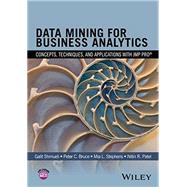Data Mining for Business Analytics: Concepts, Techniques, and Applications with JMP Pro® presents an applied and interactive approach to data mining.
Featuring hands-on applications with JMP Pro®, a statistical package from the SAS Institute, the book
uses engaging, real-world examples to build a theoretical and practical understanding of key data mining methods, especially predictive models for classification and prediction. Topics include data visualization, dimension reduction techniques, clustering, linear and logistic regression, classification and regression trees, discriminant analysis, naive Bayes, neural networks, uplift modeling, ensemble models, and time series forecasting.
Data Mining for Business Analytics: Concepts, Techniques, and Applications with JMP Pro® also includes:
- Detailed summaries that supply an outline of key topics at the beginning of each chapter
- End-of-chapter examples and exercises that allow readers to expand their comprehension of the presented material
- Data-rich case studies to illustrate various applications of data mining techniques
- A companion website with over two dozen data sets, exercises and case study solutions, and slides for instructors www.dataminingbook.com
Data Mining for Business Analytics: Concepts, Techniques, and Applications with JMP Pro® is an excellent textbook for advanced undergraduate and graduate-level courses on data mining, predictive analytics, and business analytics. The book is also a one-of-a-kind resource for data scientists, analysts, researchers, and practitioners working with analytics in the fields of management, finance, marketing, information technology, healthcare, education, and any other data-rich field.








